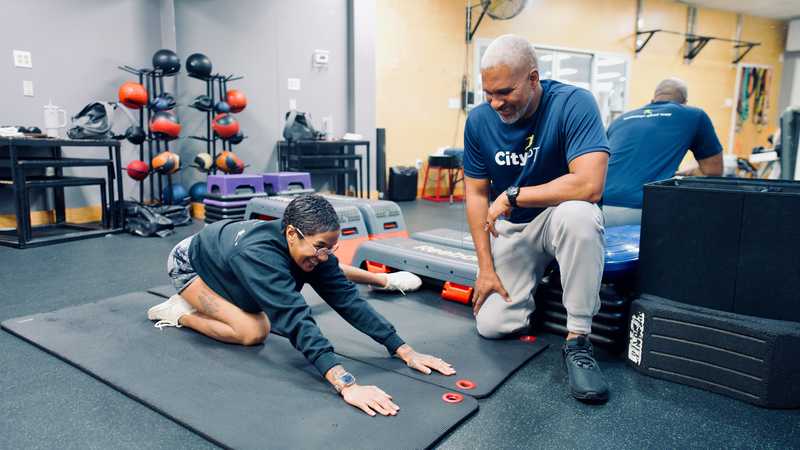Hip pain can prevent you from getting a good night's rest. Hip pain is prevalent and affects about 10% of the population.1 One common cause of hip pain is hip bursitis.
But the good news is that some excellent exercises for hip bursitis can help reduce your pain. These exercises are designed to strengthen the muscles and tissue around your hip so that you can be in less pain and hopefully prevent further damage.
This guide will cover what hip bursitis is and then discuss some of the best exercises that you can do to help you with the issue.
Key Takeaways
- Hip bursitis is a condition when the fluid-filled bursae at the hip become inflamed and cause pain.
- Exercises that can strengthen the hips and glutes may reduce pain and help to stabilize your hips.
- Pressure and friction on the bursa can worsen hip bursitis, so try to avoid certain exercises or sitting in the same position for too long.
Table of Contents
- What Is Hip Bursitis?
- Excellent Exercises for Hip Bursitis
- What Can Worsen Hip Bursitis?
- Why Won’t My Hip Bursitis Go Away?
What Is Hip Bursitis?
Hip bursitis, also called greater trochanteric pain syndrome (GTPS), is a condition that causes pain in the hip area. The pain is from an inflamed bursa, a fluid-filled sac between the bones and other soft tissue that helps reduce friction when you move.
When the bursa at the lateral hip becomes inflamed, you can have pain inside and outside your hip and even find walking challenging.
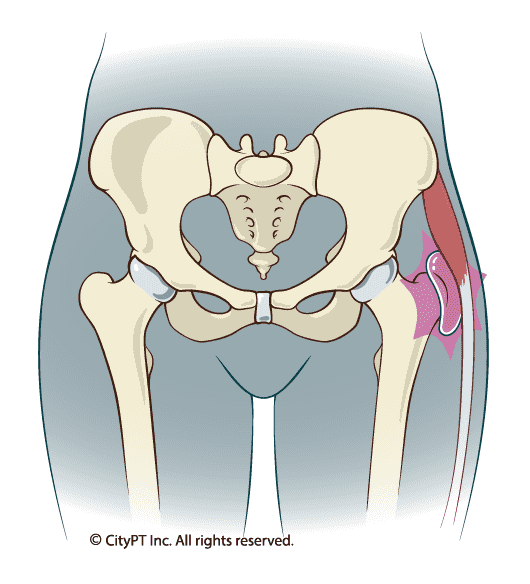
It often develops from repetitive movements, sitting for too long, or a traumatic fall onto the hip. Some other risk factors include the following:
- Lumbar spine disease
- Leg-length inequality
- Bone spurs
- Arthritis
- Previous surgery around the hip area
- Sedentary lifestyle
- Bed-bound
Some symptoms of hip bursitis include:
- Pain on the outside of the hip
- Pain along the iliotibial band
- Leg giving out
- Difficulty sleeping on your side
- Pain gets more severe when you lie down
- Difficulty getting up after you have been still for a while
Hip bursitis is common, affecting around 15% of women and 8% of men in the US.2 The go-to treatment for hip bursitis is physical therapy and NSAIDs or steroid injections. Treatment methods are typically successful.
Some people with hip bursitis find everyday activities and sleep challenging. Physical therapy exercises strengthen and stretch the area and help people return to regular activities with less pain.
WARNING: There are dangers in beginning a DIY exercise program for hip bursitis. If you are experiencing pain in your hip, we strongly advise you speak with a licensed City physical therapist before performing any of the following exercises.
For more in-depth information on hip bursitis, see our comprehensive guide.
Excellent Exercises for Hip Bursitis
If you have hip bursitis, a physical therapist can offer you some exercises that you can practice that can help to increase strength and reduce the pain in your hip joints.
Exercising the hip and buttock muscles, or glutes, will help increase stability to continue your normal day-to-day functions. The best exercises for hip bursitis will focus on the glutes and help support the hips and legs.
Hip Rotator Stretch
The hip rotator stretch is an excellent beginner stretch that can loosen up the hips.
How to perform the exercise
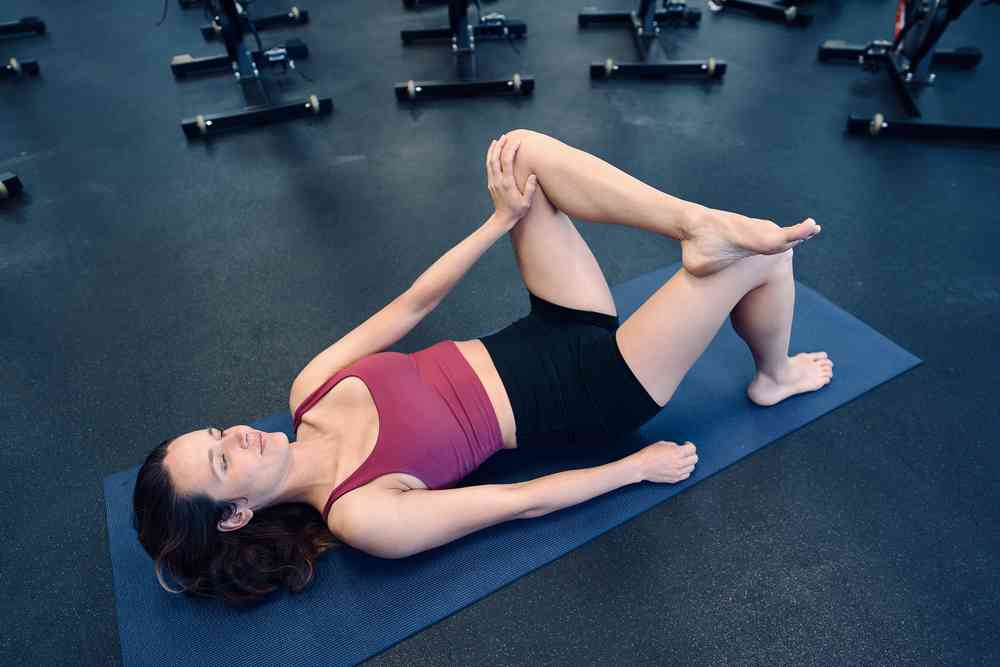
- Find a yoga mat or a blanket to lay down on. Begin by lying on your back with your knees bent and your feet on the floor.
- Pull the leg with the hip pain up and cross it over your other leg by putting your foot on your knee.
- With your hand, gently push your knee until you feel a deep stretch in your hip.
- Hold for 20–30 seconds.
- Repeat the stretch 3 to 5 times.
- Then, to balance out, repeat with the other leg if you can.
Tip from the clinic: Some of my patients feel more of a stretch if they pull their top knee towards the opposite shoulder rather than pushing it. I recommend trying both and continuing with whatever feels like a better stretch!
Iliotibial Band Stretch
Your iliotibial band extends from your hip to your knee along the outside of your thigh. When tight, your iliotibial band can worsen your hip bursitis pain. So, strengthening and stretching this area will ultimately help your hip bursitis, too.
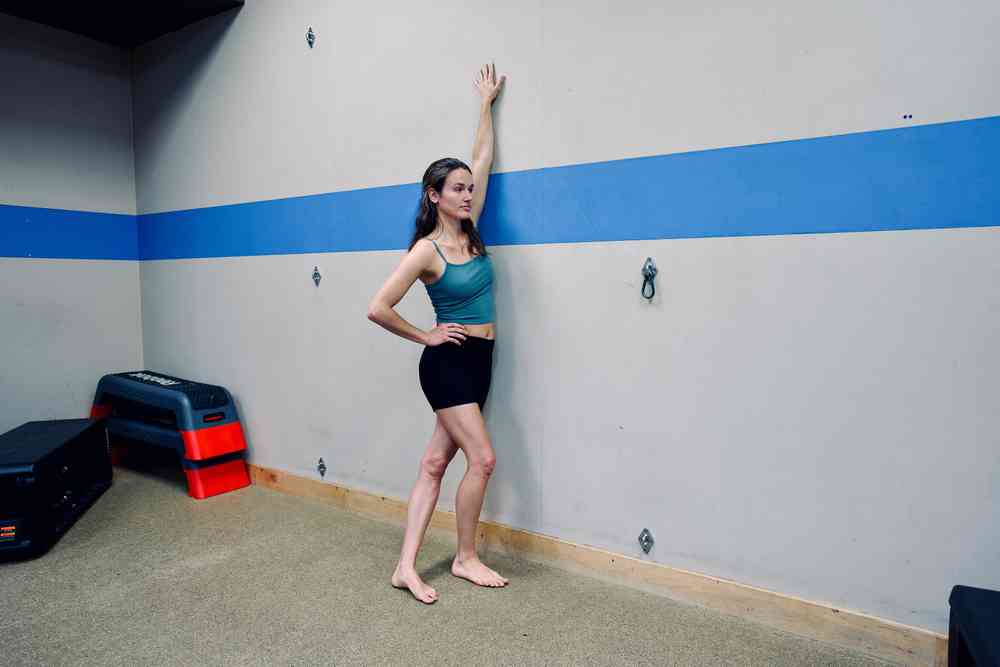
How to perform the exercise
- You can lean up against a wall sideways with your sore leg against the wall. If you need extra support, hold onto a chair.
- Put your weight on the hip against the wall and cross your other leg over it.
- Raise your arm that's against the wall up high over your head.
- Slowly press away from the wall, allowing the hip to stay close to the wall.
- It would be best if you stopped once you feel a good stretch. Then, hold in the stretch for 20-30 seconds.
- Repeat 3 to 5 times.
Straight-Leg Raises
Straight leg raises are an excellent exercise to strengthen the hip and legs. This exercise focuses on strengthening the gluteus medius and gluteus minimus muscles, which will help your range of movement.
How to perform the exercise

- Begin by laying on your side, and you want the leg with the hip bursitis to be on top.
- You'll want to prop your head up.
- Try to keep your leg straight.
- Lift your leg up in the air about a foot from the floor and keep your leg in line with the other leg.
- Hold your leg in this raised lift for ten seconds, then lower it.
- Repeat this exercise 5 to 10 times.
Clamshell
The clamshell exercise can help strengthen your glutes, legs, and hips. It works by using hip abduction and external rotation.3
Clamshells are also good for preventing further injuries in the area. You can add a resistance band to this exercise for an extra boost.
How to perform the exercise

- Begin by laying on your side with your legs bent at a 45-degree angle and your painful leg on the top.
- Prop your head up with the bottom hand and use your other arm to stabilize your body while you do this next step.
- Keep your feet together and raise the top knee as high as possible, but don't lift the bottom leg or let your hips shift.
- Hold your knee up for ten seconds.
- Then lower your knee back down and repeat 10 to 12 times with a rest in between if necessary.
Tip from the clinic: Make sure you aren’t rolling towards your back as you lift your leg.
Hamstring Wall Stretch
Practicing a hamstring wall stretch is a great way to add flexibility to your hamstrings and ultimately increase your range of movement in your legs and hips.
How to perform the exercise

- Begin by laying on your back in a doorway and put your unaffected leg through the door opening.
- Take your painful leg, stretch it up the wall, and keep your knee straight.
- You should feel a stretch in your hamstrings.
- Hold this stretch for a minute if you can.
- Then, bring your leg back down to rest and repeat 3 to 5 times.
Tip from the clinic: If laying down on the floor is too difficult, then you can sit on the edge of a chair with your affected leg stretched out in front of you. Sit up tall and lean forward by hinging at your hips until you feel a stretch in your hamstring.
Standing Quadriceps Stretch
Standing quad stretches will help to improve the mobility of your quadriceps and thighs. By improving your flexibility, you should see a reduction in hip pain or at least an increased range of motion.
How to perform the exercise
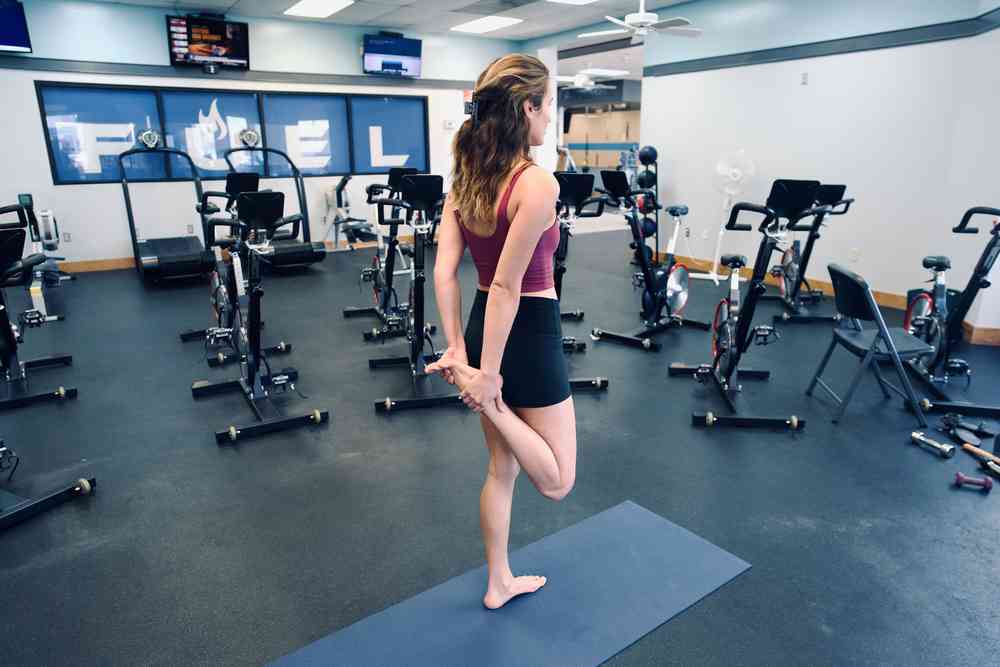
- Stand with your feet hip-width apart from each other.
- You will be balancing on one leg, so if you need support, get a chair to hold or stand by a wall.
- Stand on one foot, bend the other knee back, and pull your heel to your glutes.
- Grab your ankle with your other hand and try to stand up tall.
- You should feel a nice stretch in your muscles.
- Hold this posture for 20-30 seconds.
- If possible, let go and repeat on the other leg for balance.
Double Knee-To-Chest Stretch
The double knee-to-chest stretch is a great way to reduce hip and lower back pain.
How to perform the exercise
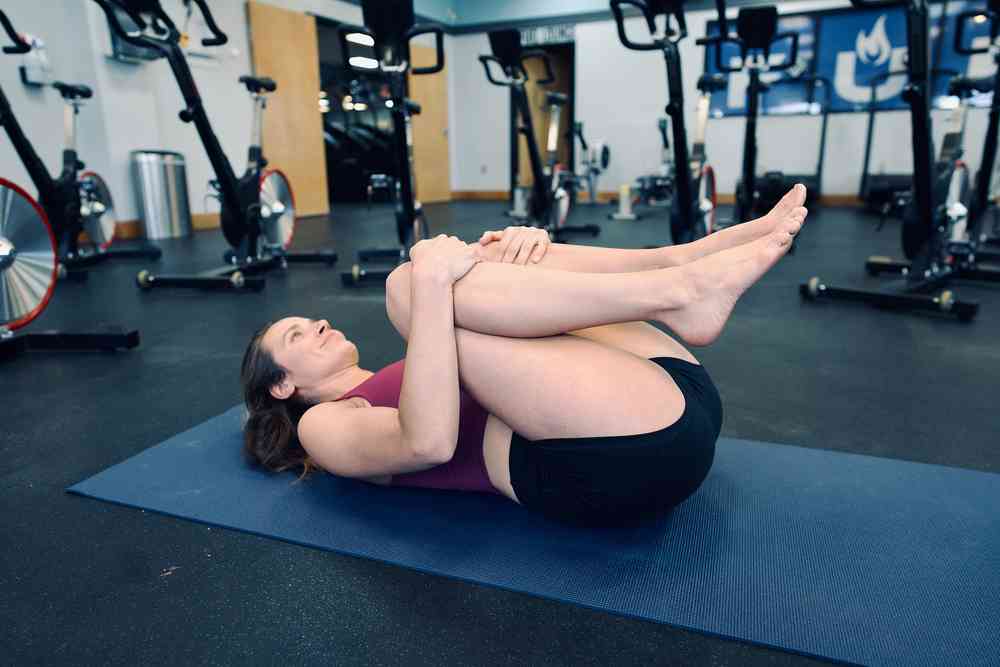
- Lie down on a yoga mat or a blanket.
- Pull your knees up like a ball and give yourself a hug, pulling them toward your chest.
- Hold this hug shape for a minute, if possible.
- Repeat 3 to 5 times.
What Can Worsen Hip Bursitis?
One of the most important factors to consider is avoiding putting too much pressure on your hip. So, you'll want to avoid sitting down for too long or repetitive stress to the hip, like running or walking up and down stairs.
There are also some exercises to avoid that may make hip bursitis worse.
These include the following:
- Running
- Jumping
- Leg lifts
- Jump squats
- Cardio
- Outer hip foam rolling
- Lunges
- Stair-climbers
- Deep squats
Why Won’t My Hip Bursitis Go Away?
If you're inflicting any pressure on the bursa, you will keep it inflamed and irritated. If you don't practice good posture or if you practice any exercises incorrectly or too often, you can exacerbate your hip bursitis.
For your safety and to ensure you're diagnosed properly, it's best to reach out to a City physical therapist so that they can show you the proper form and give you a good idea of how many are safe to do in one sitting.
Before you go, please read our disclaimer. This blog is intended for informational purposes only. We are not providing legal or medical advice and this blog does not create a provider-patient relationship. Do not rely on our blog (or any blog) for medical information. Always seek the help of a qualified medical professional who has assessed you and understands your condition.
References
Footnotes
-
Ahuja V, Thapa D, Patial S, Chander A, Ahuja A. Chronic hip pain in adults: Current knowledge and future prospective. J Anaesthesiol Clin Pharmacol. 2020;36(4):450-457. doi:10.4103/joacp.JOACP_170_19 ↩
-
Seidman AJ, Taqi M, Varacallo M. Trochanteric Bursitis. [Updated 2023 Nov 12]. In: StatPearls [Internet]. Treasure Island (FL): StatPearls Publishing; 2024 Jan-. Available from: https://www.ncbi.nlm.nih.gov/books/NBK538503/ ↩
-
McBeth JM, Earl-Boehm JE, Cobb SC, Huddleston WE. Hip muscle activity during 3 side-lying hip-strengthening exercises in distance runners. J Athl Train. 2012;47(1):15-23. doi:10.4085/1062-6050-47.1.15 ↩

Dr. Hollie Champion, a native of Charlotte, NC, is dedicated to offering innovative and accessible care for women experiencing pelvic floor dysfunction. She emphasizes a personalized and holistic treatment approach in her practice. When not working, Hollie is an enthusiastic tennis player and loves to discover Charlotte's diverse attractions with her husband, Will, and their dog, Jojo.

Dr. Hollie Champion, a native of Charlotte, NC, is dedicated to offering innovative and accessible care for women experiencing pelvic floor dysfunction. She emphasizes a personalized and holistic treatment approach in her practice. When not working, Hollie is an enthusiastic tennis player and loves to discover Charlotte's diverse attractions with her husband, Will, and their dog, Jojo.
